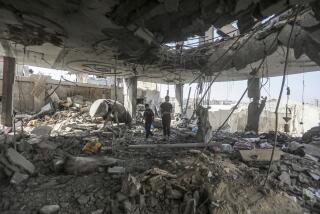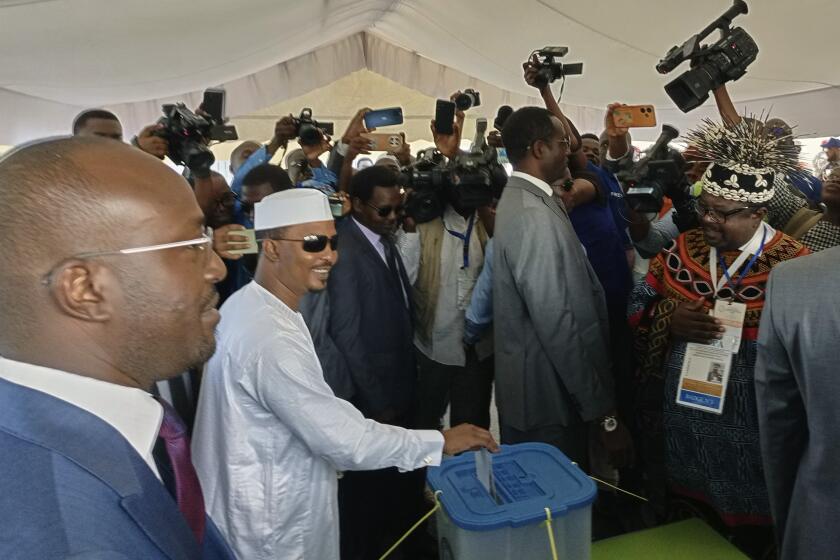Iranian TV From L.A. Is a Regime-Change Hotbed
When anti-government demonstrations broke out on the streets of Tehran last week, powerful Iranian government officials pointed the finger of blame in an unlikely direction: a string of low-budget studios centered in the San Fernando Valley.
“Be careful not to be trapped by the evil television stations that America has established,” former President Ali Akbar Rafsanjani warned Iranians during a sermon at last Friday’s prayer service in Iran’s capital.
Taking advantage of satellite technology, nearly a dozen Southern California TV stations established by Iranian immigrants are playing a growing role in the complex politics of Iran. As the warning from Rafsanjani indicates, it is a role that is harshly denounced by Iran’s ruling clerics.
But the denunciations are welcomed by local broadcasters here, some of whom boast that they have played a role in fomenting the recent unrest.
A drab North Hollywood industrial park is home to the National Iranian Television network, which provides a 24-hour-a-day broadcast of news, politics, cooking programs, pop music videos, comedy and pre-revolutionary romance films.
Starting at 11 p.m. -- mid-morning in Tehran -- former Iranian pop singer Zia Atabay appears on a set with a telephone and fax machine for a program that has the look of a public access TV show and the sound of American-style talk radio.
Atabay fields callers from Iran speaking out against their government as the fax machine churns out letters in Farsi. He listens to the voices coming out of the speakerphone and responds forcefully to viewers, many of them watching from clandestine satellite dishes in Iran. “Iran can become free,” Atabay says. “The Iranian government will not last.”
One caller, a young woman, is crying. Atabay translates her call, saying her mother was taken away by police several days earlier and she feared for her safety. Atabay says the woman asked him to tell her story to the world.
Iranian officials, who normally refrain from mentioning the U.S. broadcasts, spoke out this week after quelling one of the longest sustained protests in Tehran in more than two decades.
Speaker of parliament Mehdi Karroubi told reporters in Tehran that it was unbelievable for “some people in America to sit there and give you orders. If they have something to say, they should come to Iran and say it.”
The impact of the U.S.-based broadcasts is difficult to measure in a country where satellite dishes are illegal, though often tolerated by authorities. But the shows illustrate how technology has pierced government-imposed barriers to free speech.
Alireza Morovati, chief executive of Radio Sedaye Iran and one of the first to establish Farsi-language media in Los Angeles in 1988, said his goal from the start was getting a radio signal to Iran. But it wasn’t until 1999 that the station had the technology and money to do it, starting with a two-hour short-wave radio program titled “Toward Iran.”
Morovati’s station now broadcasts 24 hours a day. Its programs can be heard throughout the Middle East via satellite subscription or free on the Internet. More than two-thirds of its programming is political.
Many conservatives in Iran believe that the U.S. government helps fund the channels as part of an effort to destabilize Iran and turn Reza Pahlavi, the former shah’s son, into a viable political alternative, in the same manner as Washington-backed Iraqi exile Ahmad Chalabi. Pahlavi appears as a frequent spokesman for the foreign-based Iranian community on the U.S.-based shows.
And some student activists in Iran are suspicious of the political motives of network owners, as well as what they call inflammatory and often crude coverage of Iran’s domestic politics.
“They’re not really media, and they’re certainly not concerned with freedom and democracy in Iran,” said Abdollah Momeni, a student activist with the Office to Consolidate Unity in Iran, a main force in the pro-democracy movement. “They want to create a political role for themselves, to eventually impose themselves on the Iranian people.”
He and other student leaders accuse the networks of taking credit for protests in Tehran to exaggerate the influence of their programs in Iran.
Those involved in the U.S.-based broadcasting say they are providing an important outlet for people living in a country where speaking openly can bring harsh punishment.
“People of Iran, they do not have a voice.... So we took it upon ourselves ... to say the things they want us to say,” said Kambiz Mahmoudi, the host of Channel One Television’s show “One Week in One Hour,” broadcast from Woodland Hills. “They come on the air anonymously. They say what is happening in Iran, how difficult it is to live there; no jobs.”
Operators of the California-based networks say they are largely scraping by, paying for the $35,000-a-month satellite signals through a combination of advertising, donations from wealthy Iranians who fled after the revolution and smaller contributions from the more than 100,000 Iranians living in Southern California.
Countering charges from the Iranian government, the U.S. State Department said this week that it does not fund the stations and has no involvement in their broadcasts.
But bills proposed in recent months in Washington would direct tens of millions of federal dollars to U.S.-based broadcasters working to bring about a referendum in Iran, monitored by international authorities, that would ask Iranians whether they want to be ruled by elected or religious officials.
“It’s clear that those demonstrators now are getting information from the shortwave radio and satellite television broadcasts and are aware of the demonstrations because of that coverage,” said U.S. Rep. Brad Sherman (D-Sherman Oaks), one backer of the legislation. “Those who wish to suppress that information are on the losing side.”
The numbers of U.S.-based broadcasts have increased in recent months, say congressional aides in Washington, in large part because the cost of monthly satellite access has fallen by two-thirds in recent years. There is also the sense in the expatriate community, aides say, that with the war on terrorism and President Bush including Iran in the “Axis of Evil,” the time is opportune to push for change in Iran.
Some Iranian Americans are skeptical of the satellite stations, asserting that the owners are less interested in spreading democracy than making money.
In the past few years, as conservatives have gained power in Washington and lobbied for a regime change in Iran, critics charge some stations with adopting a similar line to attract financial backing from the United States.
Some Iranian American leaders say the anti-government broadcasts have intensified since May, when U.S. Sen. Sam Brownback (R-Kan.) announced he would introduce legislation allocating $50 million to Iranian opposition groups.
“Iranians are in the streets because of 20 years of suffering under this regime,” said Hooshang Amirahmadi, founder and president of the American Iranian Council and a professor at Rutgers University. “Not because a bunch of guys in L.A. tell them to come to the streets.”
*
Times staff writers Megan Garvey, Monte Morin and Teresa Watanabe contributed to this report. Fellers reported from Los Angeles. Moaveni reported from Tehran.
More to Read
Start your day right
Sign up for Essential California for news, features and recommendations from the L.A. Times and beyond in your inbox six days a week.
You may occasionally receive promotional content from the Los Angeles Times.






